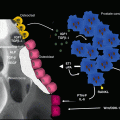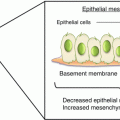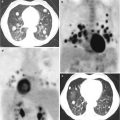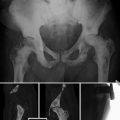Type of decay
Particle/photon
Relative mass (AMU)
Charge
Typical LET (kV/μm)
Alpha
Helium nucleus
4
+2
60–300
Beta
Electron (or positron)
1/2000
−1 electron (+1 positron)
0.1–1
Gamma
Photon
0
0
0.3 (LET associated with secondary electrons)
16.4 Clinical Applications of Beta Emitters
16.4.1 Beta Emitters as Single Agents
The early radionuclide compounds used in the modern era were beta emitters. As discussed above, strontium and phosphate have an innate bone-seeking tendency, and radioactive forms of these were used therapeutically, specifically strontium-89 and phosphorus-32 (administered as P-32-phosphate). Additionally, a number of compounds were developed incorporating an appropriate radionuclide with a bone-targeting moiety, specifically samarium-153 EDTMP, rhenium-188 HEDP and rhenium-186 HEDP.
The following Table 16.2 compares the physical properties of each of these.
16.4.1.1 Phosphorus-32
Radioactive phosphorus was one of the first radionuclides used to treat metastatic bone disease dating back to the 1950s [8]. It is rarely used clinically now particularly in the developed world. Medline searches involving “phosphorus” and “neoplasms” or “bone neoplasms” reveal no recent developments. A small study was performed in India in 1999, comparing the palliative efficacy of single-dose P-32 versus single-dose Sr-89, the rationale being that P-32 is apparently cheaper and more readily available in the developing world than imported alternatives. This small study randomised 31 patients with a range of malignancies metastatic to bone, to receive either a single dose of P-32 or Sr-89. The authors found them to broadly equivalent in terms of analgesic benefit with at least 50 % pain relief reported by 14 of 15 patients given Sr-89 and 14 of 16 given P-32 [9].
16.4.1.2 Strontium-89
Sr-89 has been extensively studied as a therapeutic radionuclide. In their robust review, Finlay et al. [10] describe 16 prospective clinical observational studies involving Sr-89. These are conglomerate data from various studies using different mechanisms of determining the very subjective experience of “change in intensity of pain” so conclusions are limited. However, “complete response” and “no response” should be consistent across trials – Finlay et al. concluded that complete response of pain to treatment with Sr-89 occurred in between 8 and 77 % of patients (mean 32 %), whilst no response occurred in between 14 and 52 % (mean of 25 %). Between these extremes, some response was reported by a mean of 44 % of patients, giving a mean overall for “some” or “complete” control of pain of 76 %.
Randomised controlled trial evidence is scant. A 1991 study randomised 32 patients with metastatic castration-resistant prostate cancer (mCRPC) to receive 2 injections, 6 weeks apart of either 150 MBq of Sr-89 or stable strontium as placebo [11]. Patients were evaluated across a number of domains including general condition, mobility, analgesia requirements and pain score; these were used to give an overall categorical score between “deteriorated” and “dramatic improvement”. In this small trial, there is a trend to improved outcome with the active agent, with all patients in the “dramatic improvement” category and a minority in the “deteriorated” category having received Sr-89. An older again and very small RCT from 1988 randomised 49 patients with metastatic prostate cancer to receive three injections of 75Mbq Sr-89 or saline placebo [12] at monthly intervals. This found no difference in palliation, but 2-year overall survival was improved in the Sr-89 group. However, this trial was underpowered to assess for survival benefit, and these results have not been demonstrated elsewhere. No recent randomised controlled trials have been undertaken examining any disease-modifying or overall survival endpoints with Sr-89 as a single agent.
16.4.1.3 Re-188 HEDP/Re-186 HEDP
As is shown in Table 16.2, two radioisotopes of rhenium have been used clinically as therapeutic radionuclides. Re-186 HEDP decays predominantly via beta decay with the release of a beta particle Emax 1.08 MeV (9 % by gamma decay, photon 137 keV); Re-188 HEDP similarly decays predominantly by beta decay with release of beta particle Emax 2.1 MeV (15 % by gamma decay, photon 155 keV) [13].
Table 16.2
Comparison of commonly used radionuclides
Therapy | Targeting mechanism | T1/2 (days) | Maximum Beta Energy (Mev) | Approximate maximum range in tissue (mm) |
|---|---|---|---|---|
P-32 | As phosphate | 14.3 | 1.71 | 8 |
Sr-89 | Calcium mimetic | 50.5 | 1.46 | 7 |
Re-188 | Via chelation with HEDP | 0.7 | 2.1 | 11 |
Re-186 | Via chelation with HEDP | 3.7 | 1.08 | 4.5 |
Sm-153 | Via chelation with EDTMP | 1.9 | 0.81 | 2.5 |
Palmedo et al. conducted a phase I dose escalation study involving Re-188 HEDP [14]. They treated 22 patients with disseminated prostate cancer with single-dose Re-188 HEDP at varying doses (1.3, 2.6, 3.3 and 4.4 GBq). Improvement in pain occurred in 64 % of patients, lasting on average 7.5 weeks. In the eight patients treated at the highest dose level, 3 of 8 developed grade 3/4 thrombocytopenia and 1 of 8 developed grade 3/4 leucopenia.
O’Sullivan et al. conducted both phase I and phase II trials involving Re-186 HEDP given along with autologous blood stem cell transplantation to abrogate the myelosuppressive effects of the radionuclide. In their phase I trial [15], 25 patients with mCRPC were treated with increasing doses of Re-186 HEDP (2.5–5 GBq) followed by return 14 days later of previously harvested autologous peripheral blood stem cells. Grade III thrombocytopenia lasting >7 days occurred in 2 of 6 patients treated with 5 GBq, making this the maximum tolerated activity. Eight of ten patients with “significant” pain at baseline had reduction in pain by ≥50 % lasting at least 4 weeks. These authors also looked for markers of disease response; 5 of 25 patients had a fall in PSA of ≥50 % lasting for ≥4 weeks.
These authors progressed on to phase II study in which 38 patients with mCRPC were treated with a single dose of 5 GBq of Re-186 HEDP followed 14 days later by autologous peripheral blood stem cell transplantation [16]. Rates of grade 3 thrombocytopenia, leucopenia and anaemia were 21 %, 11 % and 3 %, respectively. Twenty-nine percent of patients had a fall in PSA of ≥50 % sustained for at least 4 weeks. Of patients with pain at baseline, 74 % had a response of at least 1-point reduction on a 5-point pain score.
16.4.1.4 Samarium-153
The most robust phase III RCT evidence for single-agent beta emitters exists for Sm-153 EDTMP. Two relatively recent RCTs have been conducted. Serafini et al. conducted a blinded RCT comparing pain response to Sm-153 EDTMP versus placebo [17]. One hundred and eighteen patients with a range of malignancies metastatic to bone were randomly assigned to receive a single dose of 0.5 mCi/kg (18.5 MBq/kg), 1 mCi/kg (37 MBq/kg) or placebo. The high-dose group showed statistically significant improvements over placebo in both patient-rated and physician-rated pain scores at each of 4 weeks after administration. Analgesia consumption was reduced in the active groups and rose in the placebo group; although this difference was non-significant, it does suggest that the significant improvement in pain scores seen in the high-dose group is not due to changes in analgesia. Thrombocytopenia and leucopenia did occur in treated groups; however this was transient, correcting by week 8. No grade 4 toxicities were reported. A second and more recent phase III trial was undertaken by Sartor et al. [18]. One hundred and fifty-two men with mCRPC were randomised 2 to 1 to receive either a single 37 MBq/kg dose of Sm-153 EDTMP or a non-radioactive Sm-152 EDTMP as placebo. Significant improvements were seen both in subjective measures of patient pain response and analgesia consumption. There was a trend to reduced PSA in the actively treated group with 9 % of patients recording fall in PSA ≥50 versus 2 % in placebo. Sm-153 EDTMP was associated with transient thrombocytopenia and leucopenia, with counts correcting by week 8.
16.4.2 Beta Emitters in Relation to External Beam Radiotherapy
Two small studies have sought to examine the relationship between palliative EBRT to areas of painful bone metastases and radionuclides designed to target the same sites; both utilised Sr-89 as the radionuclide. One examined Sr-89 as adjuvant therapy to EBRT and the other examined Sr-89 versus EBRT. Smeland et al. [19] conducted an RCT in 95 patients with various types of cancer, all of whom had skeletal metastases. Patients all had EBRT to maximum two sites of painful skeletal metastases, treated to a dose of either 30 Gy in 10 fractions or a single 8 Gy fraction. Patients were then randomised to receive either a single dose of Sr-89 chloride at 150 MBq or saline placebo on day 1 of radiotherapy. The primary endpoint was the number of patients with physician-assessed subjective progression (progression being any of increase in pain, increase in analgesia, WHO performance status deterioration and need for additional pain treatment). No difference was found in rates of progression. Maximal haematological toxicity was ≤ grade 2 but occurred more often in patients receiving Sr-89 (≤ grade 2 haematological toxicity in 23 patients vs. 8, p = 0.02).
Oosterhof et al. conducted an RCT randomising 203 patients with mCRPC to receive either EBRT or a single dose of 150 MBq of Sr-89 chloride [20]. The radiotherapy regimes were by physician preference and ranged widely from 4 Gy in 1 fraction to 43 Gy in 24 fractions. A subjective improvement in pain was seen in 34.7 % of patients treated with Sr-89 and 33.3 % of patients treated with EBRT.
16.4.2.1 Summary of Beta Emitters as Single Agents and in Relation to EBRT
In summary, a number of beta-emitting compounds have been used in a range of metastatic malignancies. Broadly, there is observational evidence of their palliative benefit. More specifically, only for Sm-153 EDTMP is there RCT evidence for a significant palliative benefit over placebo. They are all associated with some degree of toxicity, and their dose-limiting toxicity tends to be haematological. In a single RCT, there appeared to be no palliative benefit gained from the addition of Sr-89 to EBRT. A single RCT also suggests that where disease is encompassable by EBRT, there is no significant difference in rate of improvement in symptoms for EBRT versus Sr-89.
Thus beta emitters may be effective adjuncts to analgesic medication, but for limited disease, they appear to offer little above EBRT. Where the diffuse nature and/or high volume of disease makes adequate coverage with EBRT difficult, beta-emitting radionuclides may offer a more practical and efficacious alternative. However, myelosuppression is a significant toxicity. This problem is compounded by the fact that the more diffuse a patient’s disease, the more likely they are to already be relatively myelosuppressed by virtue of the skeletal disease diminishing their bone marrow function. Thus for many patients with diffuse disease and already reduced blood counts, the risk of further myelotoxicity may be so great as to preclude radionuclide therapy with beta agents.
16.4.3 Beta Emitters in Combination with Cytotoxic Agents
The studies above have been single-systemic-agent, bone-targeted therapies in a range of malignancies. In malignancies with a particular predilection (e.g. prostate cancer) for forming bone metastases, several groups have examined the strategy of using a systemic cytotoxic coupled with a bone-targeted radionuclide. Several rationales have been proffered for these strategies. It is possible that a systemic cytotoxic might have disease-modifying action at all sites of disease, with bone-targeting agents then acting as a “consolidation” agent on the bone-based metastases. An alternative idea is that the systemic agents might act as a radiosensitiser, compounding the ultimate effect of the bone-targeted agent. A number of trials have examined this concept in beta emitters. These are covered, by radioactive agent, below.
16.4.3.1 Sr-89
A small, early study by Tu et al. [21] treated 103 men with mCRPC using a complicated regime of systemic therapies as “induction” agents (doxorubicin, ketoconazole, vinblastine and estramustine) followed by randomisation into “consolidation” therapy with either doxorubicin alone or doxorubicin + a single dose of Sr-89 (2.035 MBq/kg body weight). The trial was not designed to power any formal hypothesis testing. The authors report an increase in progression-free and overall survival in the Sr-89 arm but concede that these data are non-conclusive and merely generate the hypothesis that this type of regime may confer benefit. This combination was associated with significant toxicity. Neutropenia (<104/L) occurred in 10 patients during induction, 8 patients during consolidation without Sr-89 and 16 patients during consolidation including Sr-89. Two treatment-related deaths occurred as a result of an MI and an episode of severe neutropenic sepsis; two additional nonfatal MIs occurred. Eleven patients developed DVT.
In a departure from other studies into combination agents that concentrated on bone metastases in mCRPC, a study by Bilen et al. in 2014 examined the concept in hormone-sensitive prostate cancer (HSPC). This is an interesting study as there has been a move towards more aggressive therapy earlier in the course of metastatic prostate cancer (mPC) over recent months. Subsequent to this group publishing their results, phase III data have been published showing a survival benefit for the use of chemotherapy during the hormone-sensitive phase of the illness [22, 23]. This has prompted a shift in practice across most of the developed world to offering docetaxel chemotherapy early in the course of mPC. Bilen et al. [24] treated 79 men with a combination of ADT and two cycles of anthracycline chemotherapy plus six cycles of zoledronic acid; men were randomised to either receive additionally a dose of Sr-89 (148 MBq) or no radionuclide. In contrast to Tu et al. no study-related deaths are reported. Grade 3 bone marrow toxicity occurred in one patient in the control arm and two patients in the Sr-89 arm. No statistically significant difference was seen between PFS or OS in either arm. As the authors note, given the success of ADT, detecting a significant improvement with any additional therapy requires a study powered with very large numbers of patients.
In a final Sr-89 study, Sciuto et al. [25] tested whether or not a sensitising effect was seen by the addition of a cytotoxic to radionuclide treatment versus the radionuclide alone, rather than testing the impact of a radionuclide with a cytotoxic versus cytotoxic alone. They randomised 70 patients with symptomatic mCRPC to receive either 148 MBq of Sr-89 plus 50 mg/m2 cisplatin or 148 MBq of Sr-89 plus placebo. The cytotoxic effect of cisplatin is mediated by its formation of DNA adducts and cross-links. Its ability to potentiate the anti-neoplastic effects of radiation is well studied, and it is used as an adjunct to radical radiotherapy in multiple forms of squamous cell carcinoma including cervical, anal and head and neck. In this study, the percentage of patients whose pain score improved was significantly higher in the combined treatment group (91 vs. 63 % p < 0.01). Response scans were performed, and in the 6 months after treatment, radiological progression occurred in 27 % of patients in combined treatment group and 64 % of patients in control group (p = 0.01). Maximal haematological toxicity was grade 4 anaemia; this affected two patients in combined arm and one patient in placebo arm. No significant differences were found in platelets, leucocytes or haemoglobin in the 3 months after treatment, though there is a trend to reduced leucocytes in the combined treatment arm.
Stay updated, free articles. Join our Telegram channel

Full access? Get Clinical Tree








